Biography
Contessina de' Medici was born on 16 January 1478 in Pistoia, where her mother and her siblings had taken refuge after the Pazzi conspiracy. She was baptized in Florence shortly after her birth. Her first name, Contessina, was given to her in honor of her paternal great-grandmother, Contessina de' Bardi, wife of Cosimo de' Medici.
In May 1494 she married the Piero Ridolfi (1467–1525): a careful marriage to a man from a local Florentine family, planned by her father Lorenzo to counter local anxieties about the ambitions of the Medici, since Florentines were alarmed by the marriages of her siblings Piero and Maddalena to powerful families from other cities. [1] Lorenzo's own marriage to Contessina's mother Clarice Orsini, the first major Medici marriage to a non-Florentine noble house, had been one of the causes of the tension which led to the Pazzi Conspiracy.
In 1513 her brother Giovanni was elected Pope with the name of Leo X. Contessina then moved to Rome with her sisters Lucrezia and Maddalena, where she established herself as an influential woman in papal politics. In 1514, Pope Leo designated all secretaries of the papal curia Counts of the Lateran Court with rights and titles equivalent to an Imperial Count Palatine, including his brother-in-law, Contessina's husband.
Contessina died on 29 June 1515 and was buried in the Church of Sant'Agostino in Rome.
There is no mention of Michelangelo's possible infatuation with her before 1845, so it is probably a legend born in the Romantic era. [2]

Lorenzo di Piero de' Medici, known as Lorenzo the Magnificent, was an Italian statesman, the de facto ruler of the Florentine Republic, and the most powerful patron of Renaissance culture in Italy. Lorenzo held the balance of power within the Italic League, an alliance of states that stabilized political conditions on the Italian Peninsula for decades, and his life coincided with the mature phase of the Italian Renaissance and the golden age of Florence. As a patron, he is best known for his sponsorship of artists such as Botticelli and Michelangelo. On the foreign policy front, Lorenzo manifested a clear plan to stem the territorial ambitions of Pope Sixtus IV, in the name of the balance of the Italic League of 1454. For these reasons, Lorenzo was the subject of the Pazzi conspiracy (1478), in which his brother Giuliano was assassinated. The Peace of Lodi of 1454 that he supported among the various Italian states collapsed with his death. He is buried in the Medici Chapel in Florence.

Piero di Lorenzo de' Medici, called Piero the Fatuous or Piero the Unfortunate, was the lord of Florence from 1492 until his exile in 1494.
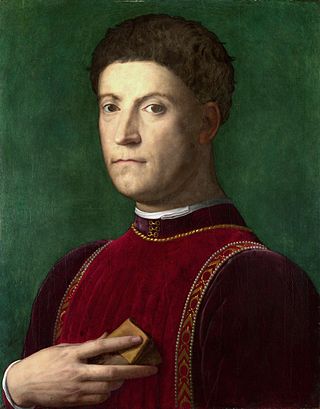
Piero di Cosimo de' Medici, known as Piero the Gouty, was the de facto ruler of Florence from 1464 to 1469, during the Italian Renaissance.
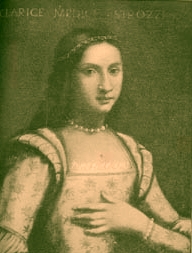
Clarice di Piero de' Medici (1489–1528) was the daughter of Piero di Lorenzo de' Medici and Alfonsina Orsini.

Giovanni di Cosimo de' Medici was an Italian banker and patron of arts.

Maddalena de' Medici was a daughter of Lorenzo de' Medici. Born in Florence, she was educated with her siblings to the humanistic cultures by figures such as Angelo Poliziano. In February 1487 she was engaged to be married to Franceschetto Cybo, son of Pope Innocent VIII. They were married in January 1488, and she brought a dowry of 4000 ducats. This marriage brought closer connections for her family and the Vatican, helping her brother Giovanni get appointed as a cardinal. She used her influence with her father, her brother Piero, and the pope to help friends and poorer people get aid and positions within the church and governments.
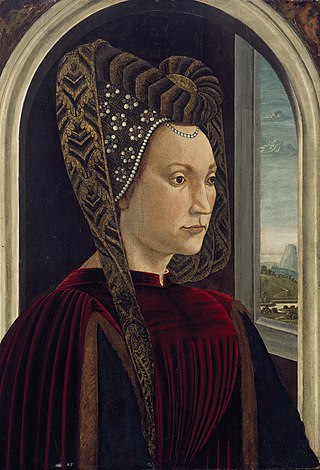
Clarice Orsini (1453–1488) was the daughter of Jacopo Orsini, and his wife and cousin Maddalena Orsini both from the Orsini family, a great Roman noble house and was the wife of Lorenzo de' Medici.

Lucrezia Maria Romola de' Medici was an Italian noblewoman, the eldest daughter of Lorenzo de' Medici and Clarice Orsini and mother of Maria Salviati and Giovanni Salviati. Her portrait was considered as the baby Jesus in Our Lady of the Magnificat of Sandro Botticelli.

Contessina de' Bardi, was an Italian noblewoman from the House of Bardi. Her marriage into the House of Medici provided her husband's family with much needed nobility, prestige, and military support as they established their power in Florence.
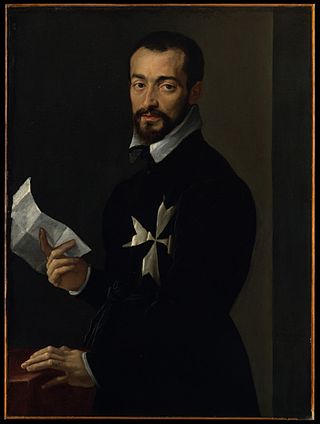
Jacopo Salviati was a Florentine politician and son-in-law of Lorenzo de' Medici. On 10 September 1486 he married Lorenzo's daughter Lucrezia de' Medici, with whom he had ten children. The son of Giovanni Salviati and Maddalena Gondi, he devoted himself to the economic affairs of the family, becoming very wealthy. He then engaged in political life. He was Prior of the Guilds of Florence in 1499 and 1518, then gonfaloniere of Justice in 1514. In 1513, he was appointed ambassador to Rome.

Lucrezia Tornabuoni was an Italian noblewoman, wife of Piero di Cosimo de' Medici, de facto Lord of Florence and his political adviser. Lucrezia had significant political influence during the rule of her husband and then of her son Lorenzo the Magnificent, investing in several institutions and improving relationships to support the needs of the poor. She was also a patroness of the arts who wrote several poems and plays.
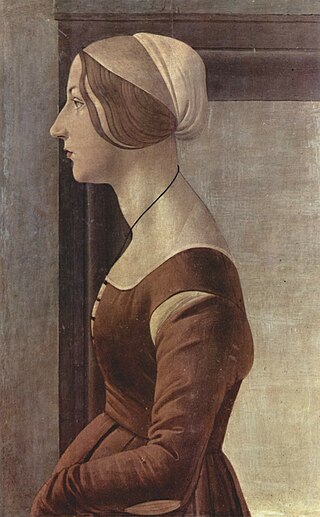
Alfonsina Orsini was a Regent of Florence. She governed the Republic of Florence during the absences of her son in the period of 1515–1519. Her rule was feared as a sign of the end of republican government there. She was born from a noble family and raised in the royal court of Naples. She was the spouse of Piero di Lorenzo de' Medici from 1488 and the mother of Lorenzo II de' Medici. She helped restore the Medicis to power after they had been exiled. She worked to secure a French royal marriage for her son, and was also influential at the court of Pope Leo X, her brother-in-law.

Gentile de' Becchi was an Italian bishop, diplomat, orator and writer. He was a member of the Platonic Academy of the Medici of Florence and tutor of Lorenzo the Magnificent and his son Giovanni de' Medici, later Pope Leo X. Of his writings there exist many letters, poems in Latin, and prayers which are praised by historian Cecil Grayson as his finest works.

Bindo Altoviti of the Altoviti family was an Italian banker and one of the most influential papal bankers of his generation. A patron of the arts, he cultivated close friendships with artists such as Benvenuto Cellini, Raphael, Michelangelo and Giorgio Vasari.
The Valori family lived in Florence during the Italian Renaissance. They were prominent in Florentine politics for five generations.
Bianca Maria di Piero de' Medici was a member of the de' Medici family, de facto rulers of Florence in the late 15th century. She was the daughter of Piero di Cosimo de' Medici, de facto ruler of the Florentine Republic, and sister of Lorenzo de' Medici, who succeeded his father in that position. She married Guglielmo de' Pazzi, a member of the Pazzi family. She was a musician, and played the organ for Pope Pius II and the future Pope Alexander VI in 1460; she was a landowner.

The Appiani family was an Italian noble family, originally from Al Piano or Appiano, a now disappeared toponym identified with the modern La Pieve in the comune of Ponsacco. They held the principality of Piombino from the early 15th century until 1628.

Medici is a historical drama television series created by Frank Spotnitz and Nicholas Meyer. The series was produced by Italian companies Lux Vide and Rai Fiction, in collaboration with Spotnitz's Big Light Productions. The series follows the House of Medici, bankers of the Pope, in 15th-century Florence. Each season follows the events of a particular moment of the family's history exploring the political and artistic landscape of Renaissance Italy.
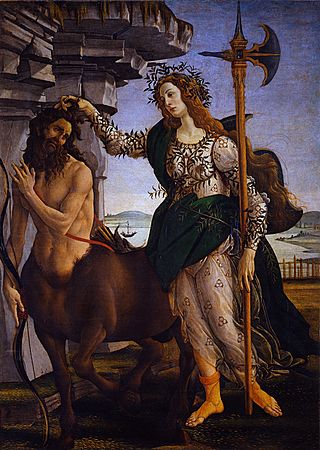
Luisa Contessina Romola di Lorenzo de' Medici, known as Luigia, was an Italian noble. She was the eightborn and fourth daughter of Lorenzo de' Medici and Clarice Orsini. She was going to marry with her fiancé Giovanni di Pierfrancesco de' Medici, but she died in 1488 at the age of 11.

The Altoviti are a prominent noble family of Florence, Italy. Since the medieval period they were one of the most distinguished banking and political families appointed to the highest offices of the Republic of Florence, friends and patrons of Galileo Galilei, Vasari, Raphael, and Michelangelo. They had a close personal relationship with the papacy. Through a predominant endogamous marriage policy they established alliances with dynasties of principal and papal nobility as the Medici, Cybo, Rospigliosi, Sacchetti, Corsini, and Aldobrandini.



















